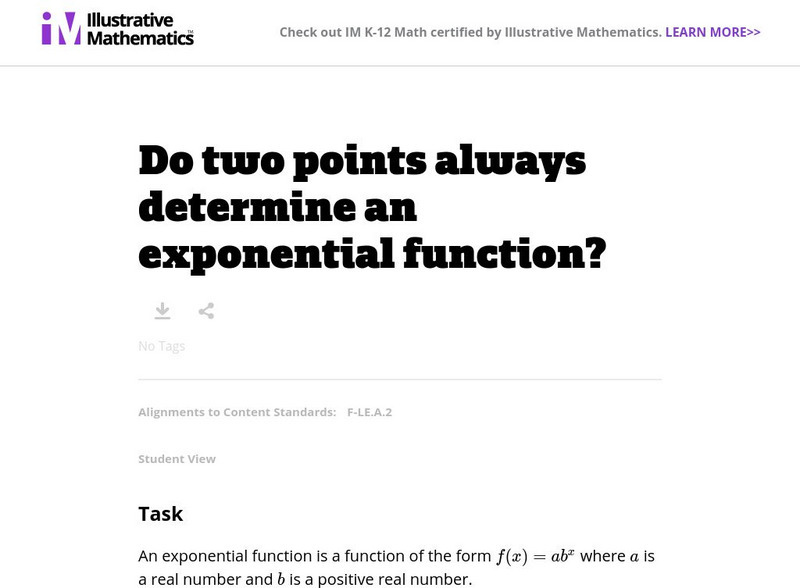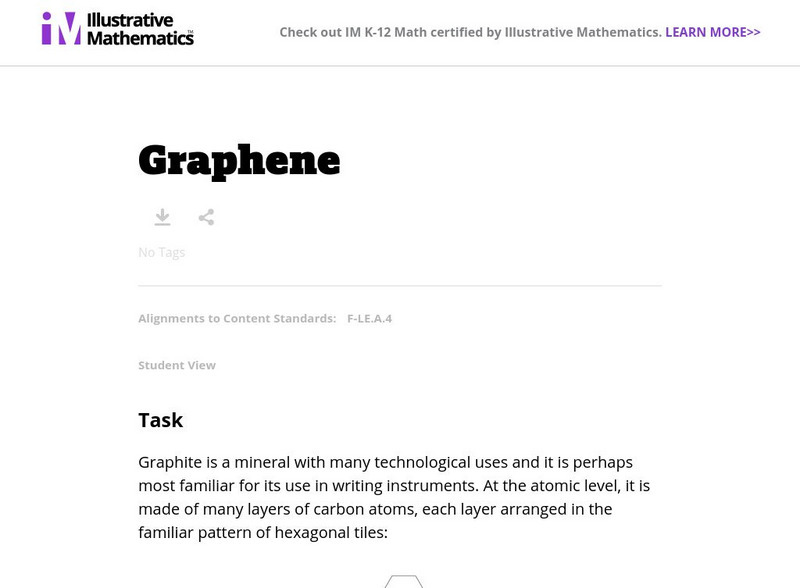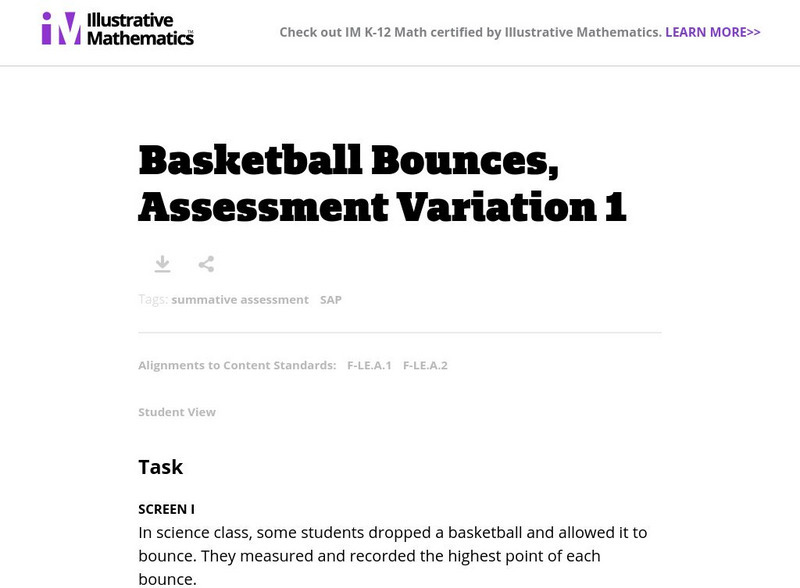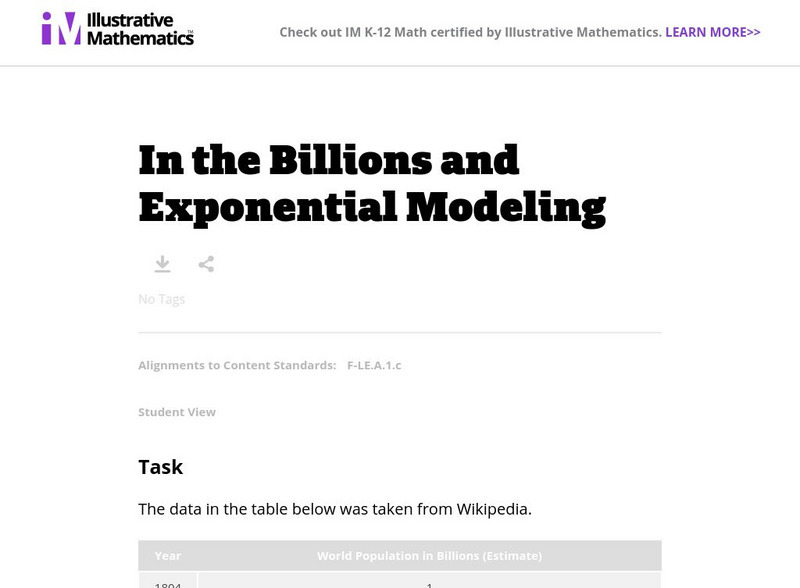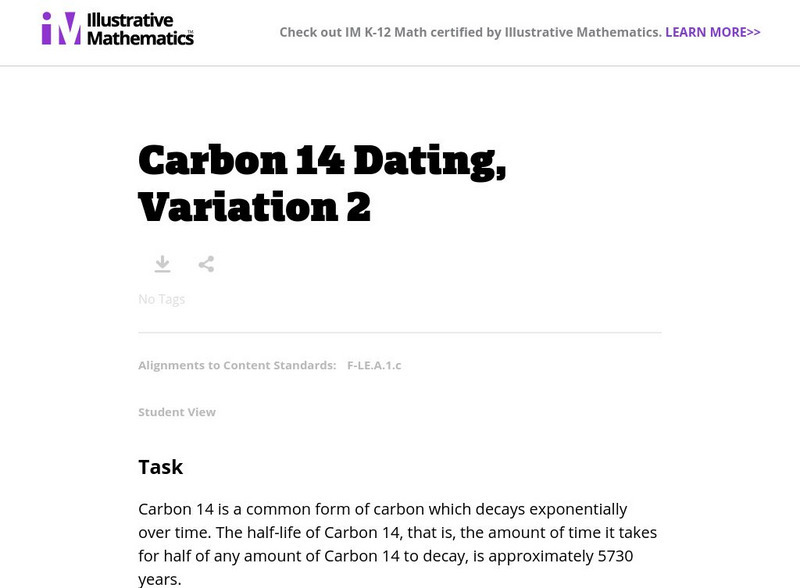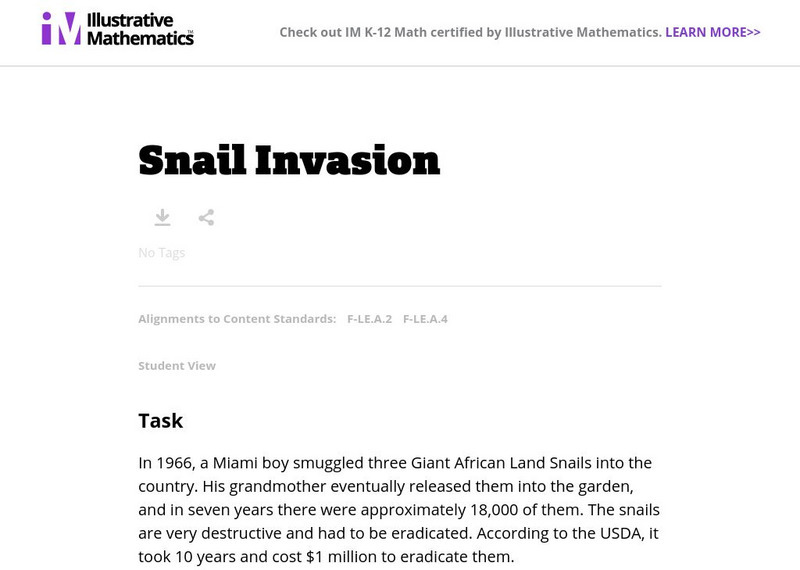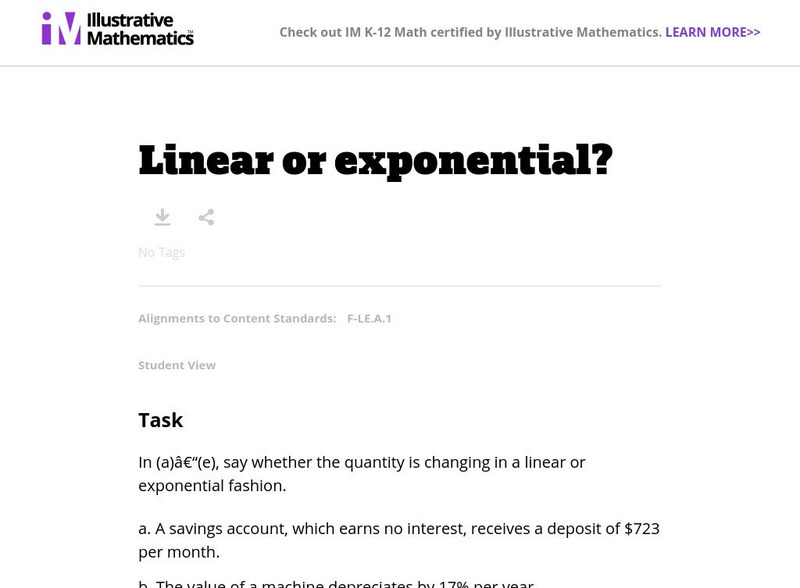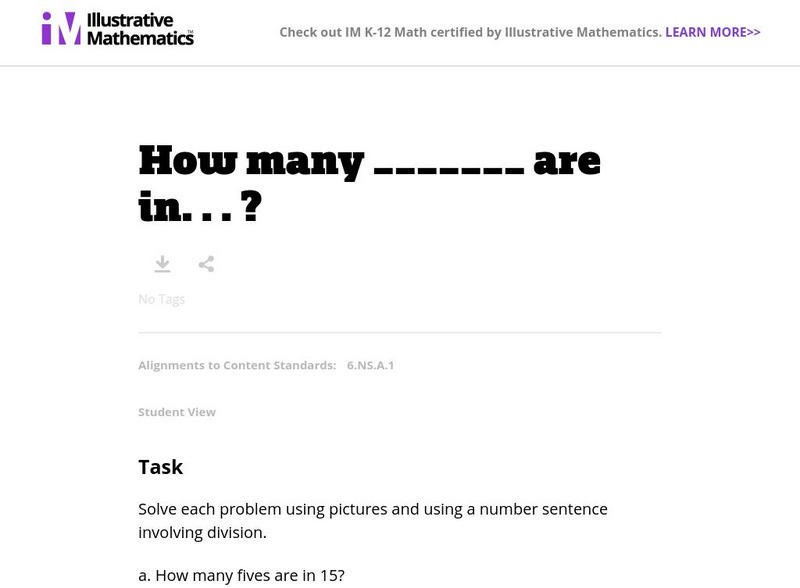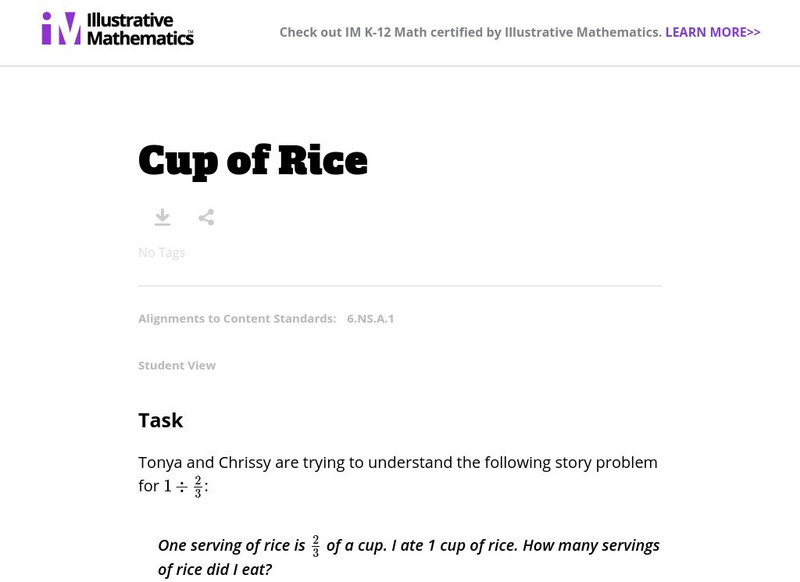Illustrative Mathematics
Illustrative Mathematics: F Le Do Two Points Determine an Exponential Function?
In this task, learners investigate whether exponential functions will always be determined by two points. It complements the task "Do two points always determine a linear function?" Aligns with F-LE.A.2.
Illustrative Mathematics
Illustrative Mathematics: F Le.4 Graphene
This task provides a real-world context for examining the power of exponential growth and decay. Students experiment, at the macro level, using scotch tape to pull a chip of graphite apart into two pieces. They are asked to find about...
Illustrative Mathematics
Illustrative Mathematics: F Le a Valuable Quarter
The context of this task is that a quarter was put into a bank account in 1901 and students are asked to calculate its value in 2013 at two different interest rates. Those amounts are compared to the appreciation rate of a rare and...
Illustrative Mathematics
Illustrative Mathematics: F Le Basketball Bounces, Assessment Variation 1
This task asks students to analyze a set of data about the height of a basketball for each time it bounces. They choose a model that reasonably fits the data and use the model to answer questions about the physical context. This variant...
Illustrative Mathematics
Illustrative Mathematics: F Le Rising Gas Prices Compounding and Inflation
In this task, students explore exponential models in the context of a real-world problem. Students learn about price inflation for a single commodity and are introduced to the Consumer Price Index for measuring the inflation of a body of...
Illustrative Mathematics
Illustrative Mathematics: F Le Basketball Bounces, Assessment Variation 2
This task asks students to analyze a set of data about the height of a basketball for each time it bounces. They choose a model that reasonably fits the data and use the model to answer questions about the physical context. This second...
Illustrative Mathematics
Illustrative Mathematics: F Le Carbon 14 Dating in Practice Ii
This problem introduces Carbon 14 dating which is used by scientists to date certain organic material. This version is based on the ratio of Carbon 14 to Carbon 12, which decreases at a constant exponential rate after an organism dies....
Illustrative Mathematics
Illustrative Mathematics: F Le in the Billions and Exponential Modeling
For this task, students examine world population data from 1804 to 2012 and investigate whether an exponential function is appropriate for modeling the relationship between the world population and the year. Aligns with F-LE.A.1.c.
Illustrative Mathematics
Illustrative Mathematics: F Le Carbon 14 Dating, Variation 2
In this task on exponential decay, students calculate what the amount of Carbon 14 left in a preserved plant will be as time passes and when one microgram will be all that is left. Aligns with F-LE.A.1.c.
Illustrative Mathematics
Illustrative Mathematics: F Le Newton's Law of Cooling
For this problem, students use an exponential equation to investigate the cooling of a cup of coffee and how long it would take for it to cool down to different temperatures. Aligns with F-LE.B.5 and F-LE.A.4.
Illustrative Mathematics
Illustrative Mathematics: F Le Carbon 14 Dating in Practice I
In this task, students learn about exponential decay by examining the amount of Carbon-14 left in a preserved plant with the passage of time after the plant has died. This provides a simple introduction to Carbon-14 dating but the actual...
Illustrative Mathematics
Illustrative Mathematics: F Le Rumors
For this task, students investigate the exponential growth of a rumor about a celebrity. Aligns with F-LE.A.2.
Illustrative Mathematics
Illustrative Mathematics: F Le, a Rei Population and Food Supply
In this task, students analyze the sizes of a country's population and of its food supply to determine when and if food shortages will occur. To solve it, they must construct and compare linear and exponential functions and find where...
Illustrative Mathematics
Illustrative Mathematics: F Le Snail Invasion
In this task, students investigate the power of exponential growth in this real-world example of an invasive species that was introduced to Florida in 1966, a giant snail. Aligns with F-LE.A.2 and F-LE.A.4.
Illustrative Mathematics
Illustrative Mathematics: F Le Linear or Exponential?
In this task, students are asked to identify whether changes are linear or exponential. Aligns with F-LE.A.1.
Illustrative Mathematics
Illustrative Mathematics: F Le Illegal Fish
For this task, students learn about exponential functions when they investigate the exponential growth of an invasive fish population. Aligns with F-LE.B.5 and F-LE.A.1.c.
Illustrative Mathematics
Illustrative Mathematics: F Le Us Population 1790 1860
In this task, students are shown a table of U.S. population data between 1790 and 1860 and are asked to explore whether exponential functions would be appropriate to model relationships within the data. The purpose of the task is to help...
Illustrative Mathematics
Illustrative Mathematics: F Le Comparing Exponentials
In this task, students work with exponential functions in a real-world context involving continuously compounded interest. They will study how the base of the exponential function impacts its growth rate and use logarithms to solve...
Illustrative Mathematics
Illustrative Mathematics: 6.ns How Many Are In. . . ?
In this task, 6th graders solve fraction division problems by drawing a picture and writing a number sentence. Aligns with 6.NS.A.1.
Illustrative Mathematics
Illustrative Mathematics: 6.ns Baking Cookies
Sixth graders are asked to do arithmetic with fractions in order to calculate the amount of ingredients they have for baking cookies and how many batches they can make. Aligns with 6.NS.A.1.
Illustrative Mathematics
Illustrative Mathematics: 6.ns Traffic Jam
Sixth graders can first model this fraction division problem with a drawing or manipulatives, then use division to solve it. Aligns with 6.NS.A.1.
Illustrative Mathematics
Illustrative Mathematics: 6.ns Cup of Rice
Sixth graders are asked to examine a drawing to find the solution to this fraction division problem. Aligns with 6.NS.A.
Illustrative Mathematics
Illustrative Mathematics: 6.ns Drinking Juice, Variation 3
In this task, 6th graders solve a fraction division problem by drawing a picture and/or using arithmetic. Aligns with 6.NS.A.1.
Illustrative Mathematics
Illustrative Mathematics: 6.ns Drinking Juice, Variation 2
In this task, 6th graders solve a fraction division problem by drawing a picture and/or using arithmetic. Aligns with 6.NS.A.1.


